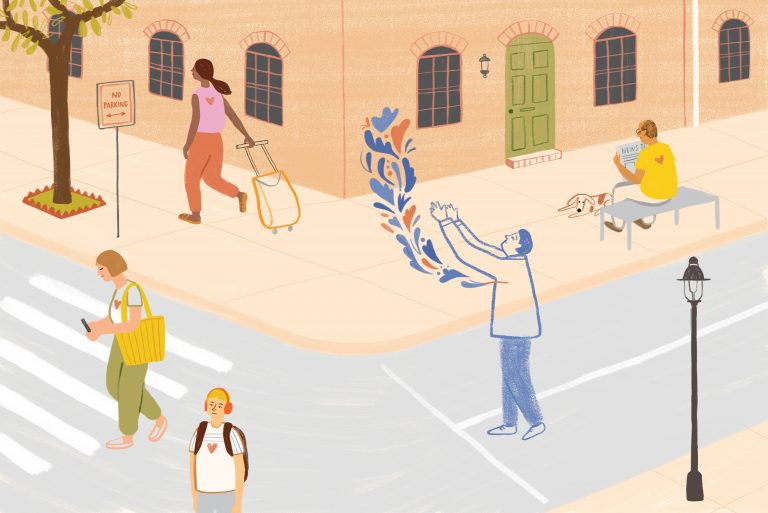The Statue of Liberty As Ishta Dev
In Hinduism, there is a tradition of offering your heart to a personal deity from amongst the pantheon of gods and goddesses. That deity is known as an ishta dev.
Your heart quickens as you think of the qualities your chosen deity is said to embody. Of all the ways a deity might be represented — as fierce, gentle, creative, protective, demanding — this is the one that calls to you, that embodies what means most in your life. This is the one that compels you to go beyond the ups and downs of daily exigencies and reminds you of why you were born.
Even after the years I lived in India, if I was ever to be asked if I had an ishta deva, without hesitation I’d respond by saying it was the Statue of Liberty. Even when I was a child growing up in New York City, she was a potent symbol for me — perhaps because my grandparents, who were first generation immigrants from Poland, raised me for some years; perhaps because the question of belonging, and the fear and heartache of not quite feeling I belonged anywhere, had become the core issues of my young life.
I saw the Statue of Liberty as affirmation that there was a place for everyone and, therefore, a place for me. She wanted and welcomed, even those who weren’t wanted anywhere else. She is a woman bearing light. She was my first symbol of bottomless compassion. I have felt a thrill go through me again and again when reading her inscription, written by the poet Emma Lazarus:
Give me your tired, your poor,
Your huddled masses yearning to breathe free,
The wretched refuse of your teeming shore.
Send these, the homeless, tempest-tost to me,
I lift my lamp beside the golden door!

I think about what it must have been like to leave the known world behind, to be desperate enough or adventurous enough or frightened enough to journey far, to begin a new life in a new land. I think about what it must have been like to see her, standing on her island in the New York City harbor, welcoming, saying “You also count. You matter. There is a place for you.”
Having adored the Statue of Liberty for a long time, I admit to having bought many photos and tacky little souvenir depictions of her in shops in New York City. In one wild flight of fancy, I considered getting a huge, five-foot tall version to startle passersby if they looked up through the second floor windows of a New York City sublet I once had. I think we can’t be reminded of her message enough.
I’ve talked about and written about one photo I have of her from the days just following the attack on the nearby World Trade Center in September 2001. In the photo she stands with dignity and certitude, lamp aloft, promising freedom and a chance to start anew to the tired and wretched, while huge plumes of black smoke billow up from behind. Beneath that smoke, I knew that in the rubble of the World Trade Center lied the heartbreak of thousands of deaths. Despite the horror and destruction, she still stands there in welcome.
I’ve certainly thought about the Statue of Liberty a lot in the last week. As I heard political conversations urging religious litmus tests for immigration, I wondered, both as a Jew and a Buddhist, if I might no longer be welcomed myself, no matter how wearying my journey and desperate my plight. As I read of one political figure admiringly bringing up internment camps for Japanese citizens during World War II as a model for what we might consider for refusing Syrian refugees going forward, I could imagine that brutal, bitter world of not belonging anywhere, not being good enough, vanquishing the beckoning world of Lady Liberty’s inscription. You don’t have to be overly sentimental, foolish, or ignorant of security concerns to recognize that abject fear distorts our vision, turning three-year-old orphans into the “other,” the “enemy.”
As a statue, this icon might one day be reduced to rubble, like the buildings that once stood nearby. Any construction can be destroyed. Between the second and fifth centuries AD, monks painstakingly carved two massive Buddhas, standing about 120 feet and 175 feet tall, out of a sandstone cliff in the area of what is now Afghanistan. Even though I hadn’t seen them on my various trips to the East, I loved the fact that they were there (and always wished I’d seen them, as several of my friends had on their overland journeys to India in the early seventies). I felt them as guardians, as symbols of peace watching over me and over the whole uneasy world.
In March of 2001, despite rigorous efforts on the part of the world community, the Taliban of Afghanistan blew them up. No matter how much I might wish they were still there, they are gone, reduced to charred rubble by tanks, shells and rockets. As soon as I heard they had been destroyed, I had the thought that the world was in deep trouble.
I’ve wondered, in this last week, if the Statue of Liberty, who stood tall and dignified as black smoke billowed nearby, might not be undone by the weight of fear and hatred billowing. Even if the statue were to be obliterated, her meaning as an icon could endure. If her inscription, her significance becomes meaningless, if compassion becomes equated with stupidity and fewer and fewer belong, any one of us might find ourselves on the outside of privilege. Then I might have to consider that five-foot personal replica after all.


Share your reflection